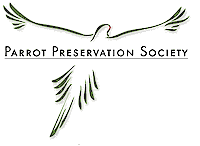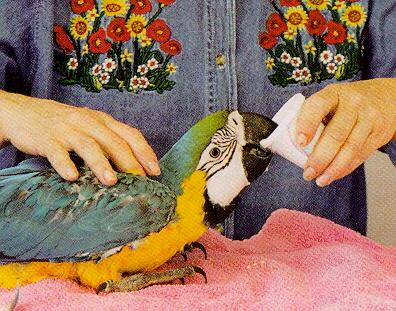 |
| Home |
| Who We Are |
| Save The Parrots |
| Books |
| Links |
| Volunteers |
| Articles |
| Avian Vet Listing |
| Email Us |
Handfeeding Techniques - A New Breakthrough For Our Birds
Box 13, Point Arena, CA 95468 USA
PH: (213) 819-1723
macaws@parrotpro.com
Over the years, the science of handfeeding our birds has largely remained unchanged. By 'our', I mean the world full of people who spend long hours, day in and day out, tirelessly making sure our little feathered charges are clean, warm, dry and full. There are several methods in current use now. Some old handfeeding methods are still used in other places in the world because more current feeding tools or information are simply not available.
Thirty years ago, on a trip deep into Mexico, I remember a street vendor patiently chewing up some corn and bread, and, removing it from his mouth, balling it up in his fingers and handfeeding it to a young Mexican Red Headed Amazon (also known as a Green Cheeked Amazon). He had no spoon, and no syringe available to him. He had probably been doing this sort of thing for years. Who knows how well his birds tolerated this somewhat unsanitary method...I only saw one bird on that entire trip.
More modern methods, those with which we are most familiar here in the states, range from tube feeding to syringe feeding, pipette feeding to spoon feeding. There are some drawbacks to each type.
Tube feeding, in my opinion, is something that should not be done unless a bird was so compromised that it was unable to feed. I would think that this would be the most severe form of feeding, and should be reserved for very, very sick birds. Tube feeding (or feeding from a squirt-type ketchup bottle) can also go terribly wrong very quickly, as an inexperienced person can easily get the tube into the lungs and kill a bird. There is no reversing a lung full of food. There is only one reason to have a tube and syringe attachment in your medicine cabinet, and that would be to remove food from a crop that is in a medical "static crop" state. For most bird feeders, that procedure would be performed under the supervision of a veterinarian. I have done it successfully, the end of the tube is inserted into the crop, and the crop is flushed with a baking soda solution and it's contents withdrawn. Conditions would be that a bird has a fungal or bacterial infection, and in removing the indigestible crop contents, the recovery can be hastened. This is safer than crop "milking." The end of the tube has several openings in the last 1/2 inch, on 4 sides, so it will not 'vacuum' itself on to the crop wall.
Syringe feeding is a bit better method, but the tendency to feed too fast is readily apparent. I have heard of people who jammed it back too far into the mouth, and filled up the opening in the back of the top of the beak, killing their baby. It was really not any fault of their own that the baby died. Even the most conscientious person who is feeding around the clock gets tired, and can make a very regrettable mistake.
There are many long time periods of feeding every two hours around the clock,, and it is hard to not make a mistake. .If you accidentally press the plunger too fast, you can aspirate them. Bits of food that will not pass the exit hole of a syringe easily can cause you to explode the food all over when it finally dislodges. What a mess! A syringe is not able to be placed in the front of the beak, and must be used from the side. This increases the chance for crooked beaks. Syringes are difficult to clean, and when they are repeatedly boiled for sterilization, tend to wear out quickly. They also can get mixed up from baby to baby, assuming the handfeeder is using one syringe for each baby.
Pipettes are similar to syringes, and are used for babies when they are very tiny, and as long as they are discarded after use, are alright until a bird can be put on our new method of feeding. Pipettes do have some advantages over syringes in not being a 'plunger' type unit. They are also very soft on young mouths.
Spoon feeding can be the messiest method, and is the most satisfactory for most hookbills so far. Once mastered, it is easy and fast. It can be a problem for many people to find someone who can correctly bend spoons to fit all the different size mouths ; fortunately we are also precious metal fabricators, and have the tools to bend our own spoons quite easily.
There is a method which is easier, more natural, faster, and more sanitary than any of the other methods. We have been spoon-feeding for a lot of years, and finally found this new method. We were looking for a way to feed that would prepare the babies to be successful breeding birds. Neither the tube, syringe or spoon method provided the necessary physical contact or stimulation that is needed.
We primarily feed macaws and conures, with a few cockatoos. If I have to artificially incubate, I start the babies on pipettes. Just as soon as they are big enough to do it, I change to small three-ounce paper cups. If the babies are parent reared, they are started on cups the moment they have the first handfeeding in the nursery. It takes them only one or two feedings to 'get it' right. This is in sharp contrast to babies who must be fussed with several times to get used to the other methods of handfeeding. The stress of transition from nestbox to nursery is also lessened.
I had been putting the formula in a community bowl, and spooning out the formula into the little 3 ounce cups, one for each baby, and then one spoon for each baby. The spoons kept falling over, as the cupful of food was not heavy enough to keep them upright. I was balancing the cup-and-spoon against the incubators, and it was impossible to control. Then Geoffrey looked at what I was doing, and told me just to eliminate the spoons and just use the cups!. I shaped the cups a little like a beak tip, and it worked quite well. This was really easy.

The babies reacted so well to the cups in their mouths, the food went down so fast and easy, I wondered why we had not thought of it before. The smallest babies, with beaks about 1/2 inch long, were fed from one single cup each. Slightly larger babies had to have two cups, stacked together, so that the cups
would not collapse. The largest macaws needed three cups stacked together, so they would be reinforced enough to stand the pumping action. The distinct advantage here is that food is never transferred from one baby to another,and the method is cleaner, quicker, and completely disposable.
In our collection, we have some syringe fed breeding birds. These birds will lay and incubate well, but they will not feed their babies. If I do not intervene, their babies will die. The parent birds simply do not understand how to feed, as they never had the experience of 'pumping' or beak to beak contact when they were being fed. The cup method also emulates this. With this new method, babies get an excellent substitute feeding experience very close to what a beak-fed bird gets; touch on both top and bottom and sides of the beak for stimulation.
To begin feeding, the cup is placed 3/4 of the way back into the mouth, and the response is very quick and strong. It takes about 30 seconds to feed a macaw this way. They enjoy it so much it is sometimes hard to get them to let go of the cup! Everyone knows that if you touch a baby on both sides of his beak, you can get a feeding response. The cup does just that...touches on both sides of the beak, so it feels just like mom feeding. Babies fed this way should respond to their own babies begging, and feed them in turn. After all, if we raise generation after generation of birds that do not know how to feed, we are being counterproductive for aviculture. I estimate how much to put in the cup by the crop size, and for the first few times, it would be better to have to refill the cup than to put too much in. Rare would be the bird that wont be a little piggy and gobble. I am right handed, so I make a 'horseshoe' shape with my left hand, and place it over the bird's shoulders. I am not holding their head or beak, or squeezing my fingers around their neck... just restraining them from rushing forward. I can feed FROM THE FRONT OF THEIR BEAK so I have reduced the possibility of beak deviations. It is thought that some beak deviations can result from handfeeding from the side of the mouth. I have the bird on a heavy towel, on a table, and the cup held pretty firmly in my other hand. Just place it in the beak, and they will do the rest. There is definitely a rhythm to this, it is pump, pump and pump!. Practice it without anything in the cup if you like, and your babies will show you how they react. I am sure that this will make baby season just a little bit easier for all of us. All the best